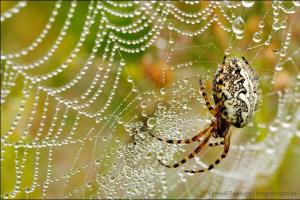Bozhikova Nelya

Good day, dear colleagues. I present to your attention master class on making« Barrel of honey» from plastic bottle .
For this we need:
- plastic milk bottle;
Stationery knife;
Spray paint or acrylic paint;
Round handle;
First, let's cut from our bottle neck, retreating from the top 3-4 centimeters. We won't need her anymore. Cut out a circle from cardboard with a diameter slightly smaller than the cut neck. This is the cover of our keg. In order for our barrel was stable, stuff it with newspaper or polyurethane foam. Paint the lid and barrel from a spray can or acrylic. When the paint dries, attach the handle to the lid and write MED.
Upon request our barrel You can decorate with flowers and attach a bee. I used this one barrel at the Autumn festival. Thanks to all! Good luck!
Publications on the topic:
 Gzhel - a Russian fairy tale Snow-white background and cobalt - blue paint... I remember Gzhel - a Russian fairy tale. Icy graceful blue rose.
Gzhel - a Russian fairy tale Snow-white background and cobalt - blue paint... I remember Gzhel - a Russian fairy tale. Icy graceful blue rose.
 Good evening, dear colleagues and friends! Today, on Mother Earth Day, I would like to offer my work. These are flowers made from plastic bottles.
Good evening, dear colleagues and friends! Today, on Mother Earth Day, I would like to offer my work. These are flowers made from plastic bottles.
 In our everyday life there is a lot of waste that can be given a second life. This is exactly what our design lesson was dedicated to.
In our everyday life there is a lot of waste that can be given a second life. This is exactly what our design lesson was dedicated to.
 Master class for preschool educators “Dymkovo young lady from a plastic bottle” Educational area: artistic and aesthetic development.
Master class for preschool educators “Dymkovo young lady from a plastic bottle” Educational area: artistic and aesthetic development.
 I bring to your attention a “compass” craft made from corrugated cardboard with children. To make it you will need corrugated cardboard of different colors, cut.
I bring to your attention a “compass” craft made from corrugated cardboard with children. To make it you will need corrugated cardboard of different colors, cut.
 Dear colleagues! My children and I love to make a variety of crafts, and colored paper and cardboard are one of the most popular.
Dear colleagues! My children and I love to make a variety of crafts, and colored paper and cardboard are one of the most popular.

A barrel of honey is the most fabulous container. All the characters in cartoons and feature films and books invariably talk not about flasks or jars, but specifically about barrels, and maybe also about pots.
What should the container be?
Storing honey is a delicate matter, because we are talking about a natural product that easily absorbs odors and substances. Once upon a time, honey was stored in clay and wooden utensils. This is where the fabulous stereotype of storing delicacies in pots and barrels emerged.
Clay and wood, of course, are good containers for such a delicate product. They do not allow moisture to enter, but still allow air to pass through. So honey enclosed in such a container can breathe. In addition, the honey pot and barrels do not allow light to pass through, which is one of the main conditions for proper storage of the product. Typically, when storing it in such traditional folk vessels, the top was sealed not with lids, but with wax.

Nowadays, the range of tableware for sweet products has expanded significantly. Barrels and pots faded into the background, giving way to other, cheap and accessible vessels.
Popular containers of our time
For the mass consumer, wooden barrels and ceramic dishes are expensive delights. The most popular and affordable utensils are containers made of glass, plastic and metal:
- Glass. This container is perfect for storing many products. Glass is chemically inert and does not allow moisture and air to pass through. The disadvantage of this container is its transparency and fragility. Besides, glassware never too big. There are, of course, 20 and 10 liter bottles, but it is not advisable to fill them with honey, because such a vessel will be very heavy. Honey is usually stored in small jars at home, in a dark and cool room.
- Plastic. This material has a low price and light weight. Plastic dishes attracts retailers. IN Lately began to use plastic cube containers adapted for storage food products. However, honey is chemically active. It quickly absorbs plastic odors and some substances. Such containers are not prohibited by GOST and sanitary control, but people still have a prejudice against plastic
- In order to store a lot of honey for a long time, beekeepers usually use aluminum flasks. They are chemically inert, lightweight and easy to transport. Use barrels from of stainless steel It is not suitable for storing honey. Metal compounds quickly pass into the contents of the vessel and make it less healing.
- A barrel of honey is considered the most environmentally friendly way to store a sweet product. The advantage of such containers is that honey in a wooden container only becomes better: it acquires the aroma of wood. It's like cognac, which is usually stored only in oak barrels. It is in this case that cognac acquires its signature oak smell. Linden honey barrels will add shades of the smell of this tree to any honey. However, not every barrel can store a sweet product. A wooden barrel should be made only from deciduous trees.
- Ceramic dishes in our time as a vessel intended for long-term storage large quantity food products has lost its relevance. The reason is its relative high cost, fragility and heavy weight in large volumes. Honey pots are popular only as a gift option, which combines the beauty of the form and the taste of the contents.

Honey barrels are usually made from oak, linden, acacia, maple, mulberry and other aromatic, but not resinous, types of trees. Ideal option is a linden tree. However, linden is also an excellent honey plant, so every felled tree is a loss for bees and beekeepers.
A barrel produced specifically for storing a sweet product can be manufactured in the following options with:
- a lid that allows the contents to be hermetically sealed;
- hoops made of various alloys and metals;
- decorative carvings;
- weaving from wicker and jute rope;
- print and logo.

In other words, this is not only packaging for a sweet product. This is a work of art that will decorate any cellar. Moreover, it is a wonderful gift, capable of pleasing any person who is not alien to the joys of life and the desire for beauty.
What is the best way to ensure safety?
Honey should be stored in any container at a temperature from +5 to +10°C. It is believed that the ideal place for this is the refrigerator. However, you can’t fit a lot of cans there.
If you have stocked up on the product in large containers, then you need to place them somewhere in the underground or the coolest corners of the house, protected from light. Honey in barrels and aluminum flasks can stand without additional shading, but transparent plastic needs to be covered with something dark. The same should be done with glass jars.
Products sent for long-term storage must be checked periodically. This should be done even if storage conditions are ideal.

The fact is that honey can separate, crystallize and ferment. Crystallization is natural process, but separation and fermentation can occur due to poor quality production. Usually such incidents happen with a product that contains a lot of water. As a result, the bactericidal properties of honey are weakened, which leads to increased activity of fungi and bacteria.
Such honey can increase in size, which leads to leakage from the vessel, tearing off the lid and other troubles. As a result, not only are the medicinal and taste properties lost, but in the absence of a sealed lid, the foaming liquid may leak out of the vessel. For this reason, you should never fill the vessel right up to the lid; you should leave some free space in case the fermented mead climbs like dough, tearing off all the lids.

Bees take a long time to prepare their product. They pass the collected nectar through their crops, enriching it with enzymes, and then dry it for a long time. And only after a sufficient amount of water has evaporated from the sweet preparation, it becomes honey and is sealed with special wax caps.
In an effort to start selling their goods earlier, beekeepers can remove early, not yet dried honey. It cannot be stored. You just need to eat it soon. It is advisable to purchase autumn products for storage, preferably in September.
For long-term storage of honey at home, it is best to use wooden barrels. glass jars and aluminum flasks. Plastic, despite the fact that it is considered food grade, still has its own smell, incompatible with the aroma of the bee product.
Thus, storing honey is a complex and delicate process. The more sweet amber you stock up on, the more care is required to ensure its safety.
How long can honey be stored?
The duration of this process depends not only on storage conditions and packaging, but also on the condition of the product itself, which can be:
- thick;
- liquid;
- in honeycombs.
It is believed that the most healthy honey- it's liquid. However, there is danger in this preference. The fact is that some unscrupulous producers in the spring may sell not fresh, but melted honey. Eating such a product is not only useless, but also dangerous. During heat treatment, complex biochemical reactions occur, as a result of which substances hazardous to health appear instead of useful ingredients.

Real fresh honey is not only liquid, it is transparent, with a bouquet of sharp spicy odors or delicate floral aromas. It is this product that is maximally saturated with vitamins and other useful substances. At proper storage honey it thickens, becomes sugary, gradually losing some of its properties. However, these losses are not significant. Throughout the year, such honey can be consumed with a clear conscience. A product stored for more than a year still has many beneficial properties. At least it is not harmful to the body. However, such terms are already beyond all sanitary recommendations.
But honey in honeycombs, when properly stored, does not lose its nutritional and medicinal qualities for 10 years. No wonder it is sold at inflated prices. This product does not come from beekeepers, but from the bees themselves. IN wooden barrel honeycombs are laid, from which honey flows. Honeycomb is a wax that is also beneficial to the body. It has the property of an adsorbent, so you need to consume honey along with honeycombs, chewing and swallowing the sweet wax.
Thus, the safety of honey depends on many factors. The material from which the container is made plays an important role in this process. A pot and a barrel of honey are considered the best option product safety. Followed by glass containers, the only drawback of which is transparency and fragility. Plastic and metal have questionable qualities.
Cooperation is one of the most difficult crafts, so the answer to the question is how to make a barrel with your own hands, it won’t be easy either. This is a very labor-intensive process that requires the performer to have a decent professional level and the availability of a large number of tools for wood processing.
Types of barrels by purpose and wood for their manufacture
Before you get interested, how to make a barrel, you need to decide what you need it for. The choice of material and manufacturing method depend on this. This type of container is manufactured for the following purposes:
- for fermentation, aging and storage of spirits, wine and beer;
- for preparing and storing pickles;
- for storing dry products;
- for storing honey, etc.
Beverage barrels have two bottoms and a hole for inserting taps. The same type of container, but without holes, was previously used for long-term storage of certain products (for example, corned beef).
For other purposes, barrels with one bottom are sufficient - they are also called tubs. They are covered with a lid or a circle on top for oppression. These parts are much easier to make than the bottom. Make a wooden barrel possible from such wood species as:
- oak;
- ash;
- cherry;
- Linden;
- alder and others.
Wood of the first three types is the most universal. It is equally suitable for containers for any purpose. However, the “champion” should be recognized oak barrel, which, being strong, reliable and durable, provides ideal conditions for storing food.
Oak products have antiseptic properties, release tannins into alcoholic drinks, improving their taste, and also easily withstand the effects of brines when preparing pickles. Ash and cherry are the first “substitutes” of oak wood. They have similar, but weaker properties. Therefore, we will consider, . Making containers from other types of wood, such as linden, has no fundamental differences except for some nuances finishing.
 Oak barrel for honey
Oak barrel for honey Rules for procuring material for barrels
Before you start doing DIY wooden barrel, should be prepared and prepared quality material. The wood must be mature, healthy, and free from defects (knots, cross-layers)

The best time for procurement of material is late autumn or winter, when natural humidity wood is at a minimum level.
It is unlikely that you will be able to meet all the requirements. For example, for the production of staves for wine and cognac barrels of the highest quality category, the process of drying and aging wood takes 6–8 years, but if you are only concerned with how to make a barrel for yourself, adhere to the following rules:
- Before drying, the logs are split into pieces of the required thickness;
- drying is carried out in a closed area sun rays place - under a canopy, in a barn, etc.;
- The duration of drying depends on many factors and can take 1–3 months;
- The residual moisture content of the wood before treatment should be about 25%.
Accelerating the drying process using hot air and other methods usually leads to a deterioration in the quality of the wood and its properties in finished product. The advice also takes into account the need to condition the processed rivets before assembling the product. As a result, the residual moisture content of the wood should be 17–20%.
Making rivets and tools for this
For those interested make your own oak barrel The most difficult part will be making the rivets. The process of marking and chopping logs is clearly presented in the following figure

As a result, you will receive blanks of conical cross-section, from which, after drying, they are made into rivets. This part has a complex shape, so its production places high demands on the skill of the performer. The main dimensions of the barrel and its elements, depending on the volume, are as follows:
This table will help you figure out how to make a barrel, and the drawing - to understand how to give the rivets the required form
 Tool
Tool and what tools you will need for this. The curvature of the sides should provide the barrel with a taper of about 8°, due to which the product becomes resistant to loads from the outside and inside. To process the surfaces of rivets, a plane, jointer, sherhebel, plow and other tools of this group are used. Wherein outside surface the parts should have a slightly convex shape, and the inner part should have a concave shape.
|
Barrel capacity, l |
Height, mm |
Center diameter, mm |
Diameter at the edges, mm |
Riveting width, mm |
Rivet thickness, mm |
Thickness of bottoms, mm |
The accuracy and quality of planing are regularly checked using a template. To calculate the number of rivets, the longest circumference (at the center of the barrel) should be divided by the width of the workpieces. This way you will also determine the exact and uniform size of the part. The process of making rivets can be seen in the video.
After this, the answer to the question of how to make an oak barrel with your own hands, will become clearer as you tackle the toughest challenge.
Making bottom shields and tools for this
To make bottom shields, 4–6 planks are used, connected to each other with wooden or stainless steel pins. Drawings, or, more precisely, instructions, of this process are given here

But at first we will limit ourselves to only connecting the planks, since other operations are carried out taking into account the dimensions of the assembled barrel body. We just have to do the following:
- draw a circle on the shield: its diameter should correspond to the size of the bottom of the barrel, to which is added twice the depth of the morning groove (this is 6 mm);
- perform filing along the contour using a bow saw or a circular saw;
- chamfer around the entire circumference so that the bottom fits into the morning groove.
In a similar way (adjusted for a larger or smaller diameter), the lid and the circle for oppression are made. If you intend make your own barrel for drinks that have two bottoms, you should remember that such products are made according to individual measurements for the top and bottom. You will see the result of your efforts only after you collect all the details into a single whole. Assembling the barrel is the most enjoyable stage of its manufacture. We will describe how this process is carried out below.
Barrel assembly procedure
The following information about how to make a barrel, there will be recommendations for its assembly. For this, besides wooden parts, you will need metal hoops - assembly and permanent. The first of them serves to set and fix the complete frame. Permanent hoops are divided into morning and neck (umbilical) hoops. They provide tightening of the rivets. To make a wooden barrel from the available set of parts, you will need to perform the following operations:

- using clamps, fix two, or preferably three, rivets on the assembly hoop;
- Fill the space between them with the remaining parts;
- put on a neck hoop on the fixed side;
- steam the loose side of the frame and tighten the rivets using a collar (noose), after which put a morning and neck hoop on this side of the frame;
- from the side of the assembly hoop, cut a morning groove to install the bottom;
- cut and process the first bottom, and then put it in place;
- On the same side, install a morning hoop, which finally fixes the bottom;
- carry out finishing treatment of the internal and external surfaces of the barrel body;
- carry out hardening (firing) from the inside;
- Repeat the operation of installing the bottom on the opposite side.
The initial stage of assembly can be seen in the video
.
Another video
will give an idea of subsequent operations. However, in this case, an allowance should be made for the fact that professionals work here who have their own techniques and perform many actions automatically. Perhaps not everything will work out the first time, but how to make your own oak barrel, you will definitely learn.
For barrels with a capacity of up to 50 liters, four hoops are used; for larger containers, their number is increased to six. They are made from steel strip 30–50 mm wide and 1.5–2 mm thick. The diameter of the hoop is determined by measuring the location of its installation on the body of the product. Double the bandwidth is added to the resulting value. This is necessary to connect the strip into a ring using rivets made of malleable steel wire with a cross-section of 4–5 mm.
Answering the question, how to make a barrel, it is necessary to mention that one edge inside the hoop requires flaring. This gives it the necessary taper for a tight fit to the frame rivets when putting on and setting down. Cutting a morning groove is done using a special tool, which in professional slang is called a morning groove. The procedure is somewhat reminiscent of opening a round tin can.
In an article about how to make a barrel, we cannot fail to mention the hardening of the product. Most often this is achieved by firing. This ensures increased wood resistance to moisture, organic acids and other influences. It is most convenient to fire a body without a bottom using a burner such as a portable forge.

Surface finishing and drilling of holes for taps (chops) are done before firing.
Checking the barrel and preparing it for use
Our advice on how to make a wooden barrel with your own hands, completes with information on how to check its tightness and prepare the product for use. To search for leaks, the barrel is filled with water. If it is still leaking within an hour of filling, you will need to take steps to seal it. For this, there is a proven “old-fashioned” method using cattail, which is also called barrel grass. They use it to caulk leakage areas. Another method of sealing is waxing using natural wax.
Each master has his own answers to the question, how to make a barrel, and many professional secrets, to reveal which one would have to write an entire monograph. Therefore, you will have to repeatedly seek help from experts in the most different nuances barrel making process. By the way, the literary hero Robinson Crusoe was never able to cope with this task. When you achieve the tightness of the product, all that remains is to prepare the barrel for use.
Answering the question, how to make an oak barrel, you should also give recommendations for soaking it. Most often this is done using ordinary water. The procedure takes up to 10 days with fluid changes every two to three days. However, for barrels intended for spirits, soaking lasts from one month to six months using alcohol-containing liquids with an alcohol content of 18–55%. In this article we have tried to answer basic questions regarding how to make a barrel. We hope you find this information useful.
MK Imitation wood, glaze. "Gift Barrel for Honey"
1. We will need two plates of different sizes (the difference should not be very large, about one and a half to two centimeters) and a container that will then be located inside the gift barrel;

2. We will need corrugated cardboard. We cut out circles from corrugated cardboard: 1 circle - large (within which we cut out a circle for further gift packaging) Trace the gift along the most protruding part and then be sure to try it on, and if our gift hardly fits into the hole, enlarge it a little. 2 circles of smaller diameter with holes inside and 1 circle of smaller diameter without inner hole. We will also need 1 circle of thin cardboard (whatman paper can be used), but its internal hole should be 1-2 mm narrower than the other internal holes;

3. In order not to have to worry about calculations, I took a flexible centimeter and measured the circumference of our circles. The larger one turned out to be 52 cm and the smaller one was 46.

4. We need to determine how many centimeters in height the barrel will be (the height of the gift + the bottom and top of the barrel), I added 2 cm at the top and bottom (4 cm in total)
We also need to determine how many cm in length we should make the pattern of the barrels. Our barrel will consist of two canvases. Since our largest circle is 52 cm in circumference, we boldly add 3 cm, and maybe even 4 cm. (Depends on the thickness of the cardboard - the thicker it is, the more centimeters it will eat). The first half of the barrel is larger than the second, look at your box (how long it is). Our first ring will be located in the middle of the barrel and on the canvas we look for the middle, draw a straight line and from it another 2.5 - 3 cm up and down we draw lines (we get a strip of 5-6 cm. In the middle of this strip we will glue a larger circle)! !! The cardboard has corrugated grooves; they should run vertically. Next, we need to knead 5 centimeter-thick strips along these grooves (hereinafter the boards of our barrel) and since circles of smaller diameters will be at the top and bottom, we make darts like on a skirt (we cut along the fold line of each future board and cut to the mark that we we did it by measuring the middle) Cut to the mark closest to the edge and cut out the dart (you should get a triangle);

5. On the smaller half of the barrel we do the same.

6. This way the larger circle will be located in the middle;

7. Cut out strips 1 cm * 2-2.5 cm.

8. Glue with glue;

9. Those places where we made darts on the sides of the barrel (on two halves) - crumple with our fingers and round off from the mark where the darts end (we do not take into account the area where the large circle will be located, we only round off the tops and bottom), glue the strips onto the circles made of corrugated cardboard with holes. The following are left without stripes: a circle without a hole made of HA and a circle with a hole made of thin cardboard.

We glue our circles with holes: two smaller circles down and up (departing from the edges approximately 1 cm.) The glue is not super fast and you have to squeeze hard to get it to stick. You can tie them with elastic bands or strings of any kind to, let’s say, tighten our circles to the maximum.

While the glue dries, let's work on the lid:
We cut off the smaller circle, which is intended for the lid, a little along the edge so that the lid is flush with the top of the barrel.

We cut out 6 strips: 4 smaller and 2 larger, try them on the lid;

glue two strips together;

We glue two more smaller circles to the top circle;

The two bottom circles should be less than the top by a maximum of 1 cm. Try the bottom circles on the barrel so that they fit completely and lie on the top circle of the barrel, the circle with the hole.

We cover the finished lid and the element with which we will open it later with yacht varnish.

We treat all holes and irregularities with papier mache, sand, putty, sand again, cover with yacht varnish, glaze... see further.

We choose where our barrel will have the top and pour glue into the corrugated grooves and begin to crumple the cardboard, gluing the upper and lower parts between which the grooves are located (there should be the effect of thin cardboard.) If the three parts that make up the GC are separated, then we glue them very well to avoid air bubbles in the future. If we have air bubbles, our putty will fly around. To the bottom of the barrel, to the bottom circle with a hole, glue a circle without a hole.
While the first strip is being glued, you can apply glue to the second. While it dries on the last board, glue the previous one.

You can help yourself and clamp the tops with something while they are glued (either with clamps or clothespins, just be careful so that the clamps do not stick to the barrel),

After we have everything glued, we varnish the outside of our entire barrel thoroughly with yacht varnish.

Prepare papier mache mixture. We cut the napkins into small pieces and fill them with PVA; it is better to take a larger container;

We cover all the holes with papier mache solution, remove the excess with a cloth. When the solution dries it will be difficult to sand. The remaining solution will go to the bottom of the barrel;

This is what the barrel and lid with holder look like, treated with papier mache.

After drying, we sand the entire product and apply putty, smoothing out all the unevenness. Don't forget to apply putty to the bottom and level it with a spatula.

We also apply putty to the lid and holder;

We take a spatula and at an angle of 45 degrees we begin to draw our tree, all the knots and grooves;

After the putty has dried we take sandpaper and we clean everything up. We align everything. We coat all places with putty with yacht varnish. The putty will yellow slightly from the varnish.

Next, we need to think about the internal state of our barrel. We take whatman paper and roll it into a tube, coat our holes in the circles with glue, insert whatman paper and glue it to the sides of the holes in the circles;

We make notches on the top of the Whatman paper with scissors, bend it and cut off the excess. Glue the folded parts to the top circle of HA;

On top we glue a circle of thin cardboard with an internal hole slightly smaller than the circles made of GC. , We coat the top and the Whatman paper tube with yacht varnish;

After the varnish has dried, we cover all the cracks with putty, then again with yacht varnish, wait for it to dry;

We prepare brushes, a cloth and paints for glazing. “Tair” paints brown, white and gray, ocher; "Plaid" 915;

Mix gray “Tair” and brown “Plaid” 915 paints and apply the first layer, wait for drying;

Do not forget to paint the lid along with the barrel to avoid discrepancies in color;

We added splashes of Tair ocher, bleached the dark brown a little to light brown and sprinkled it further, then we applied dark splashes - take gray paint and apply it with some water on top, giving the effect of dusty antiquity. Next, we play with color;

Don’t forget to apply all layers to the barrel lid. After we achieve the desired result and are satisfied with it, we put brown dots on the lid, near the holder, imitating carnations;

After all the layers of paint have dried, we can coat the barrel with the finishing varnish in one layer, I use “Technolog” varnish. Next, after the varnish has dried, we begin to draw the boards. To make our barrel more like a real one, we will draw small triangles on the edges of the lines, imitating cracks;

We also draw boards on the lid;

We draw our knots with brown paint, highlight all the grooves or those that we want to highlight;


Since our barrel tapers towards the bottom and towards the top, we will need to make a pattern for our hoops first from paper, cut thin strips and equip ourselves with double-sided tape.
We remember where our pattern will begin and begin measuring in small pieces. For convenience, the beginning of the pattern can be glued to the barrel with a small piece of tape. We make sure that the strip runs straight along the top; as soon as it starts to go down, we tear it off and glue the next strip onto double-sided tape so that it runs evenly. Leave an overlap.

This is the curved pattern we got. We put notches where the beginning is and mark the top. We turn the barrel over and use the same pattern to make a pattern;

We cut off the top and bottom of the tin can, cut it lengthwise to form a rectangle, and cut off any unevenness for safety reasons!!! For convenience, we will paste several small strips of double-sided tape onto the paper pattern and place it on tin can. We also glue a piece of tape to the edge of the tin pattern and glue a tin piece to it, continuing the pattern...

We clean the resulting tin pattern from the paint layer, do not remove the paper pattern yet.

Those places where we were fastened with tape (tin to gesture) we will need to connect them;

To do this, we take either an awl or a tailor's needle (a thick needle) and make two holes at the joints, helping with either a hammer or heavy pliers. Be sure to place an unnecessary magazine so as not to spoil the table. We try on the rings to the barrel and close them with pieces of wire. We bend the wire in the shape of the letter P and clamp it from the inside out like a bracket with pliers;

We take a sponge and apply brown paint to the tin using tapping movements. If you decide to make a pattern (squeeze out) on the tin, then use bitumen varnish rather than paint (it will show all the patterns, but there is a drawback - it smells terrible)

We process both rings and wait for drying;

We remove the paper pattern, remove the tape with a napkin or cloth, use coarse sandpaper to go over the rings for better adhesion to the glue, glue the hoops and pull them onto the barrel, pressing so that they stick. If the glue doesn’t work, then you need to take a hot gun. Next we coat it with finishing varnish and apply decoupage.

If you are interested, I have a video of MK.








